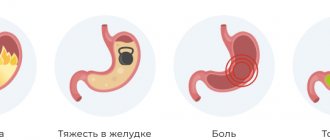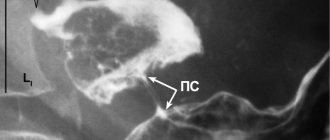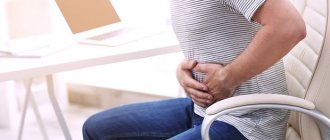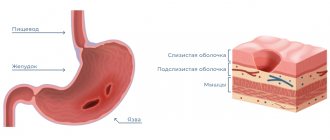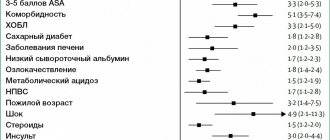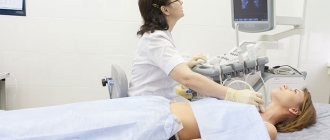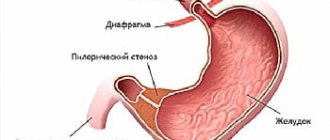Author of the article: Sergey Vyalov, gastroenterologist, hepatologist, Ph.D.
The duodenal bulb (DU) is called the bulbar region. Hence the name of the disease: bulbitis is an inflammation of the mucous membrane of the duodenal bulb. It is quite popular that bulbitis causes gastritis. Actually this is not true. The diseases are interconnected, but still develop in parallel to each other.
General rules
The initial part of the duodenum, adjacent to the sphincter of the pyloric part of the stomach, is called the bulb.
The acidic contents of the stomach enter the bulb and begin to bring its pH to alkaline, which does not irritate the underlying parts of the small intestine. The duct of the pancreas and gall bladder opens in the bulb and digestive enzymes begin to operate. Inflammation of the mucous membrane of the bulb is called bulbitis . Gastritis often interrelated processes, and therefore the term gastric bulbitis is often used, which is incorrect from an anatomical point of view. Bulbit refers only to the duodenal bulb. The acute form of the disease can be caused by poisoning, consumption of alcohol and its surrogates, and use of medications. The main cause of the chronic form is Helicobacter pylori infection, giardiasis , helminthic infestations and Crohn's disease .
Helicobacter pylori infection against the background of poor nutrition (irregular intake, excess spicy foods in the diet) and prolonged stress (activates acid formation in the stomach) causes dysfunction of the duodenum and inflammation. Brunner's duodenal glands, which normally produce an alkalizing secretion that neutralizes stomach acid, are damaged. The resulting duodenogastric reflux (bile enters the stomach through the bulb) against this background further reduces the protective barrier of the mucous layer and maintains constant irritation and inflammation of the mucosa.
According to gastroduodenoscopy, inflammation can be: catarrhal (simple inflammation), and erosive, when surface defects appear on the mucous membrane - erosions, which can be accompanied by bleeding (hemorrhagic variant of the disease).
The most characteristic is aching pain in the epigastric region and in the right hypochondrium, occurring 1-2 hours after eating. At the initial stage of the disease, loss of appetite, heartburn, belching, flatulence appear. Erosive bulbitis often manifests itself as burning pain radiating to the back, and it occurs at night or on an empty stomach. The appearance of bitter belching and vomiting with the presence of bile indicates the reflux of intestinal contents back into the stomach. During an exacerbation, patients experience increased fatigue, malaise, sweating and other autonomic disorders.
In the treatment of the disease, proper nutrition is of no small importance. The diet for erosive duodenal bulbitis is prescribed the same as for peptic ulcer disease and depends on the stage of the disease (exacerbation or attenuation of the process). Most often, patients with this pathology have increased acidity, so during an exacerbation, Diets No. 1A and No. 1B , which are prescribed sequentially. , Diet No. 1 may be recommended . Table No. 2 may be recommended .
During the period of exacerbation, bulbitis of the duodenum occurs with severe pain and dyspeptic disorders, so it is necessary to create rest for the gastrointestinal tract with the most gentle nutrition. In such cases Diet No. 1A , which maximally limits all effects of food on the mucous membrane and creates all the conditions to reduce inflammation and restore the mucous membrane. This is especially important in the presence of erosions.
The diet is recommended for the first days of treatment while the patient is on bed rest. Reducing the amount of protein and fat, limiting carbohydrates and salt, certain methods of cooking and its liquid consistency - all this spares the mucous membrane as much as possible. Such nutrition can be prescribed (depending on the severity of the disease) for 5-14 days.
Nutritional features at this moment:
- Eating food only pureed and in a liquid or mushy state.
- Any broths (food is cooked in water) and mucosal irritants (any vegetables and coarse cereals) are excluded.
- Avoid foods that are difficult to digest (legumes, mushrooms, tough meat, fish and chicken skin, even pureed).
- Cold and hot dishes are not allowed, as they irritate the mucous membrane and slow down its recovery.
- 6 meals a day are provided and the amount of food per meal is limited, which also reduces inflammation.
This diet allows:
- Slimy soups - they are strained decoctions of cereals (semolina, rice, oatmeal), and the cereals themselves are not consumed. Butter and whipped egg-milk mixture are added to such soups.
- All meat and fish products are thoroughly beaten in a blender or passed through a meat grinder several times. Steam soufflés or pates are prepared from minced meat.
- Steam soufflé made from pureed non-acidic cottage cheese (preferably calcined), milk and cream. Any fermented milk drinks are not allowed.
- Steam omelette made from whole eggs.
- Liquid porridge made from cereal flour (buckwheat, rice, oatmeal), cooked in water or with the addition of milk. You can also eat pureed porridge from boiled cereals, but dilute them greatly with water, milk or cream. Butter should be added to prepared porridges.
- Kissels made from sweet berries (they are pureed), the use of fruit jelly and honey, diluted fruit juices is allowed.
- Drinks include weak tea with milk, bran decoction, rosehip infusion.
In the stage of calming down of the process or immediately, if the exacerbation is not expressed, patients are prescribed loading Diet No. 1B . It has significantly fewer restrictions, the amount of basic food components and calorie content has been increased, but the salt restriction remains. The diet is balanced and the timing of its observance is individual (10-30 days). You can already eat white bread croutons, pureed soups and pureed cereals, canned vegetable and fruit baby food are introduced. Fish and meat dishes are still recommended in the form of minced meat, soufflé, quenelles, cutlets or puree.
After this, the main Table No. 1 , and in case of mild exacerbation it is prescribed immediately. This is a moderately gentle and complete diet in terms of protein, fat and carbohydrates and can be followed for a long time. It is advisable to limit the amount of salt.
- Indigestible, coarse foods, secretion agents and dishes with an irritating effect are excluded: stringy meat, wholemeal bread, poultry skin and fish, mushrooms, turnips, radishes, asparagus, radishes, legumes, white cabbage, fruits with rough skin (grapes, currants, gooseberries, dates), mustard, horseradish, hot sauces, etc.
- The diet is divided into small portions, you cannot take long breaks (4 hours) between meals, and it is also recommended to chew it thoroughly.
- Dishes are prepared boiled and occasionally baked; more often they are pureed, but fish and tender meat can be eaten in pieces.
In this way, the patient gradually prepares for the transition to a common table. But even if you feel well in a state of remission, it is not advisable to consume large amounts of spices and herbs, spicy foods, smoked foods, fatty and fried foods. The diet should also limit legumes, coarse fiber and carbohydrates - foods that cause fermentation and putrefaction in the intestines. Below are permitted and prohibited foods, menus and recipes for Diet No. 1 .
Diagnosis of bulbitis
Diagnosis of the disease begins with questioning the patient. The doctor needs to tell you what symptoms of the pathology the patient experienced and how they developed over time. The specialist must also find out whether the human body has been affected by any active chemicals - whether the patient has taken drugs from the group of non-steroidal anti-inflammatory drugs, or whether he has recently taken alcohol. This will allow us to establish the potential cause of acute bulbitis.
Based on the clinical picture, a specialist may suspect the presence of a pathological process and prescribe the necessary procedures. The standard of care involves prescribing the following studies to the patient:
- FGDS;
- Clinical blood test;
- Coprogram;
- Detection of Helicobacter pylori infection - breath analysis, invasive diagnostic techniques, enzyme immunoassay or PCR.
The main diagnostic method is endoscopy of the gastrointestinal tract. Using this technique, the doctor can examine the mucous membrane in real time and detect signs characteristic of intestinal disease. In acute cases, round erosions of the bulbar region are detected in the wall of the organ, which are surrounded by inflamed tissues. Based on the study, it is possible to determine what form of pathology a person has - focal or confluent.
Chronic erosions have a different structure. The formations are usually covered with plaque, due to which they rise above the surface of the surrounding tissues. There are usually no acute inflammatory processes around the erosions. Based on the characteristic picture, a specialist can diagnose bulbitis and accurately determine its clinical form.
Authorized Products
- Soups are prepared with vegetable broth (all broths, cabbage soup, okroshka and borscht are excluded). Soups should contain well-cooked or pureed cereals and finely chopped or pureed vegetables.
- It is allowed to introduce an egg-milk mixture, season soups with cream and butter.
- You can only eat dried wheat bread (highest grade).
- Chopped steamed dishes (meatballs, pate cutlets, meatballs) are prepared from lean meat (beef, lamb, pork, turkey, chicken). Soft meat can be cooked in pieces, or boiled tongue can be eaten.
- Lean fish is prepared in the same way - chopped or in pieces, but without skin. Jellied fish in vegetable broth is allowed.
- Dairy products are represented by cream, milk, cottage cheese, yogurt and non-acidic kefir. Souffles, lazy dumplings and cottage cheese casseroles are prepared from cottage cheese.
- From semolina, buckwheat and rice cereals, pureed porridge of a semi-viscous consistency is prepared in water or milk.
- Butter and vegetable oil are added to ready-made first courses and porridges.
- Vegetables allowed include potatoes, cauliflower, carrots and beets. They are steamed and served as purees and steamed puddings.
- You can drink weak tea with added cream or milk, sweet juices, jelly. The use of jellies and fruit purees is allowed, and compotes only with pureed fruit. Sugar and honey are added to dishes.
Table of permitted products
| Proteins, g | Fats, g | Carbohydrates, g | Calories, kcal | |
Vegetables and greens | ||||
| cauliflower | 2,5 | 0,3 | 5,4 | 30 |
| potato | 2,0 | 0,4 | 18,1 | 80 |
| carrot | 1,3 | 0,1 | 6,9 | 32 |
| beet | 1,5 | 0,1 | 8,8 | 40 |
Cereals and porridges | ||||
| buckwheat (kernel) | 12,6 | 3,3 | 62,1 | 313 |
| semolina | 10,3 | 1,0 | 73,3 | 328 |
| cereals | 11,9 | 7,2 | 69,3 | 366 |
| white rice | 6,7 | 0,7 | 78,9 | 344 |
Bakery products | ||||
| white bread crackers | 11,2 | 1,4 | 72,2 | 331 |
| wheat bread | 8,1 | 1,0 | 48,8 | 242 |
Confectionery | ||||
| jelly | 2,7 | 0,0 | 17,9 | 79 |
Raw materials and seasonings | ||||
| sugar | 0,0 | 0,0 | 99,7 | 398 |
Dairy | ||||
| milk | 3,2 | 3,6 | 4,8 | 64 |
| kefir | 3,4 | 2,0 | 4,7 | 51 |
| cream | 2,8 | 20,0 | 3,7 | 205 |
| curdled milk | 2,9 | 2,5 | 4,1 | 53 |
Cheeses and cottage cheese | ||||
| cottage cheese | 17,2 | 5,0 | 1,8 | 121 |
Meat products | ||||
| boiled beef | 25,8 | 16,8 | 0,0 | 254 |
| boiled veal | 30,7 | 0,9 | 0,0 | 131 |
| rabbit | 21,0 | 8,0 | 0,0 | 156 |
Bird | ||||
| boiled chicken | 25,2 | 7,4 | 0,0 | 170 |
| turkey | 19,2 | 0,7 | 0,0 | 84 |
Eggs | ||||
| chicken eggs | 12,7 | 10,9 | 0,7 | 157 |
Oils and fats | ||||
| butter | 0,5 | 82,5 | 0,8 | 748 |
Non-alcoholic drinks | ||||
| mineral water | 0,0 | 0,0 | 0,0 | — |
| black tea with milk and sugar | 0,7 | 0,8 | 8,2 | 43 |
Juices and compotes | ||||
| juice | 0,3 | 0,1 | 9,2 | 40 |
| jelly | 0,2 | 0,0 | 16,7 | 68 |
| rose hip juice | 0,1 | 0,0 | 17,6 | 70 |
| * data is per 100 g of product | ||||
Causes
There are a variety of reasons why erosive bulbitis (erosive gastritis) occurs, which include the following:
- violation of nutrition rules;
- prolonged stress;
- infectious processes in the digestive organs;
- genetic factor;
- deterioration of immunity.
Each of these factors in itself is very important and indicates a high risk of a pathological process. Among the main causes of the disease is the aggressiveness of one’s own immune system, which negatively affects pathogens and healthy cells of the body.
Fully or partially limited products
- Fermented milk products with high acidity.
- Dishes that stimulate secretions and irritate the mucous membranes are excluded: meat/fish broths, mushrooms, fried and stewed dishes, hot and sour sauces, broth-based sauces, smoked meat and fish products, pickles and pickled vegetables, canned food, spices and seasonings (horseradish, mustard, mayonnaise).
- Rye bread, any fresh bread, confectionery products made from puff pastry.
- Millet, pearl barley, barley and corn cereals, pasta, legumes.
- White cabbage, radish, sorrel, cucumbers, tomatoes, onions.
- Sour and coarse fiber fruits/berries.
Table of prohibited products
| Proteins, g | Fats, g | Carbohydrates, g | Calories, kcal | |
Vegetables and greens | ||||
| spicy vegetables | 2,8 | 0,5 | 5,3 | 36 |
| vegetables legumes | 9,1 | 1,6 | 27,0 | 168 |
| canned vegetables | 1,5 | 0,2 | 5,5 | 30 |
| stewed vegetables (fried) | 2,0 | 6,8 | 8,0 | 106 |
| daikon | 1,2 | 0,0 | 4,1 | 21 |
| cabbage | 1,8 | 0,1 | 4,7 | 27 |
| cucumbers | 0,8 | 0,1 | 2,8 | 15 |
| radish | 1,2 | 0,1 | 3,4 | 19 |
| white radish | 1,4 | 0,0 | 4,1 | 21 |
| turnip | 1,5 | 0,1 | 6,2 | 30 |
| horseradish | 3,2 | 0,4 | 10,5 | 56 |
| garlic | 6,5 | 0,5 | 29,9 | 143 |
| sorrel | 1,5 | 0,3 | 2,9 | 19 |
Mushrooms | ||||
| mushrooms | 3,5 | 2,0 | 2,5 | 30 |
Cereals and porridges | ||||
| corn grits | 8,3 | 1,2 | 75,0 | 337 |
| pearl barley | 9,3 | 1,1 | 73,7 | 320 |
| wheat bran | 15,1 | 3,8 | 53,6 | 296 |
| millet cereal | 11,5 | 3,3 | 69,3 | 348 |
| barley grits | 10,4 | 1,3 | 66,3 | 324 |
Flour and pasta | ||||
| pasta | 10,4 | 1,1 | 69,7 | 337 |
Bakery products | ||||
| oatmeal bread | 10,1 | 5,4 | 49,0 | 289 |
| Rye bread | 6,6 | 1,2 | 34,2 | 165 |
| bran bread | 7,5 | 1,3 | 45,2 | 227 |
| doctor's bread | 8,2 | 2,6 | 46,3 | 242 |
| whole grain bread | 10,1 | 2,3 | 57,1 | 295 |
Confectionery | ||||
| jam | 0,3 | 0,2 | 63,0 | 263 |
| candies | 4,3 | 19,8 | 67,5 | 453 |
| pastry cream | 0,2 | 26,0 | 16,5 | 300 |
| butter cookies | 10,4 | 5,2 | 76,8 | 458 |
Ice cream | ||||
| ice cream | 3,7 | 6,9 | 22,1 | 189 |
Cakes | ||||
| cake | 4,4 | 23,4 | 45,2 | 407 |
Chocolate | ||||
| chocolate | 5,4 | 35,3 | 56,5 | 544 |
Raw materials and seasonings | ||||
| mustard | 5,7 | 6,4 | 22,0 | 162 |
| ketchup | 1,8 | 1,0 | 22,2 | 93 |
| mayonnaise | 2,4 | 67,0 | 3,9 | 627 |
| ground black pepper | 10,4 | 3,3 | 38,7 | 251 |
| chilli | 2,0 | 0,2 | 9,5 | 40 |
Meat products | ||||
| pork | 16,0 | 21,6 | 0,0 | 259 |
Sausages | ||||
| dry-cured sausage | 24,1 | 38,3 | 1,0 | 455 |
| sausages | 12,3 | 25,3 | 0,0 | 277 |
Bird | ||||
| smoked chicken | 27,5 | 8,2 | 0,0 | 184 |
| duck | 16,5 | 61,2 | 0,0 | 346 |
| smoked duck | 19,0 | 28,4 | 0,0 | 337 |
| goose | 16,1 | 33,3 | 0,0 | 364 |
Fish and seafood | ||||
| dried fish | 17,5 | 4,6 | 0,0 | 139 |
| smoked fish | 26,8 | 9,9 | 0,0 | 196 |
| canned fish | 17,5 | 2,0 | 0,0 | 88 |
Oils and fats | ||||
| creamy margarine | 0,5 | 82,0 | 0,0 | 745 |
| animal fat | 0,0 | 99,7 | 0,0 | 897 |
| cooking fat | 0,0 | 99,7 | 0,0 | 897 |
Non-alcoholic drinks | ||||
| black tea | 20,0 | 5,1 | 6,9 | 152 |
| * data is per 100 g of product | ||||
ethnoscience
When erosive bulbitis occurs, folk remedies and methods for treatment are widely used. They are used as an adjunct to drug therapy. Good means are:
- propolis tincture;
- wheat sprouts;
- sea buckthorn oil;
- green apples.
For prolonged pain, propolis tincture helps to cope with the problem. Another good way to get rid of inflammation and soreness is sea buckthorn oil. You can purchase it ready-made or prepare it yourself.
Before carrying out treatment with traditional methods, you must first consult with your doctor, as they may have certain contraindications.
Menu for erosive bulbitis (Diet mode)
Alternating different protein and cereal dishes will make your diet varied. The additional introduction of baking also diversifies the diet. Meat or fish dishes are consumed 2 times a day, plus the protein part of the diet is supplemented with cottage cheese, eggs, milk and non-acidic kefir. At night, it is preferable to consume cream or milk, and if whole milk is poorly tolerated, you should give preference to non-acidic kefir or yogurt.
| Breakfast |
|
| Lunch |
|
| Dinner |
|
| Afternoon snack |
|
| Dinner |
|
| For the night |
|
| Breakfast |
|
| Lunch |
|
| Dinner |
|
| Afternoon snack |
|
| Dinner |
|
| For the night |
|
| Breakfast |
|
| Lunch |
|
| Dinner |
|
| Afternoon snack |
|
| Dinner |
|
| For the night |
|
Classification
There are 2 main forms of bulbitis - acute
and
chronic
. The latter is characterized by the duration of its course, structural changes in the mucous membrane with subsequent dysfunction. Acute pathology occurs as a result of intestinal infection or poisoning and is accompanied by pronounced symptoms. In addition, bulbit comes in several types.
Surface
This type is easy to treat because only the surface of the intestinal mucosa is affected, causing swelling. Swelling interferes with the release of digestive juices, forming stagnation, causing poor digestion.
Catarrhal
This variety is a serious consequence of the prolonged course of surface bulbite. Added to the swelling is the expansion of capillaries, impaired intestinal motility, and reflux (reflux of gastric contents back into the esophagus).
Focal
Focal bulbitis is characterized by damage to an entire area of the intestinal mucosa, and is not concentrated in one place. Inflammatory foci spread either towards the intestines or go towards the stomach. It can occur against the background of hormonal imbalance, aggravated by strict diets and vitamin deficiency.
Erosive
With bulbitis of an erosive nature, the lesions reach the muscle layer, forming mucosal defects. Most often this is caused by bacteria. With the erosive-hemorrhagic type, an admixture of blood appears in the stool. The chronic form is asymptomatic, but is characterized by discomfort after a small snack (a feeling of fullness), and aching pain at night is possible.
Erythematous
Characterized by the appearance of red spots on the mucous membrane (hyperemia).
Follicular
During endoscopic examination, you can notice that small nodular vesicles (follicles) cover the intestinal wall. This is a reaction of the lymphatic vessels to helminths, Giardia. Predisposing factors include neglect of hygiene, weak immunity, and poor quality nutrition.
Atrophic
When tissues die (atrophy), the functions of the mucous membranes are lost.
Erosive-ulcerative bulbitis
Recipes
When preparing dietary dishes, you must follow certain rules. When steaming, food should not come into contact with liquid, but should be treated with boiling steam. The loss of all substances in this case is less than during cooking. Omelettes or egg porridge must be cooked in a water bath - the container with the product is placed in another larger one filled with water.
The use of cereal flour (rice, buckwheat or oatmeal) will speed up the cooking process. In a blender you can easily and quickly puree boiled meat and vegetables. This diet involves the preparation of cream soups and puree soups. They are prepared from various vegetables, as well as a mixture of vegetables and cereals; you can add rolled boiled chicken meat. All products are first boiled, pureed or whipped with a blender and the resulting thick mass is diluted with vegetable broth if you are preparing a puree soup, or with milk and cream if you want to get a cream soup. Add a piece of butter to prepared dishes.
First meal
Puree rice soup with meat
Boil chicken or beef and blend in a blender. Cook the rice until fully cooked and also grind in a blender or puree. Add meat to the pureed rice, add water to the desired consistency and boil. Add a piece of butter.
Oatmeal soup with zucchini (grated)
Boil the peeled zucchini and drain the vegetable broth. Boil oatmeal or flakes well. Grate the zucchini and cereal, dilute with vegetable broth, bring to a boil and add salt. Add butter to the finished soup. Serve with croutons.
Second courses
Egg porridge
Beat eggs with milk, add salt and butter. The whipped mass is poured into a mold, which is placed in a container with hot water. Cook while stirring until it reaches the consistency of porridge. There is another cooking option. The prepared egg mass is poured into a saucepan with water (a small amount is needed) and cooked like porridge, stirring and bringing until thickened. Excess water needs to be drained.
Steamed chicken cutlets
Cutlets are made from raw chicken or turkey. Choose meat without tendons and skin (the ideal option is breast). The meat is twisted several times or beaten using a blender, soft butter, milk, salt, and beaten egg whites are added, small cutlets are formed and steamed for 20-25 minutes.
Dessert
Curd soufflé
The cottage cheese needs to be rubbed well, add the yolk, milk, a little flour and sugar. Beat the whites until foamy and fold into the curd mixture. Steam in any form. Can be served with fruit jelly or condensed milk.
Raspberry jelly
Boil raspberries or other sweet berries for 2-3 minutes, adding a little water. Rub through a sieve. Add sugar to taste to the resulting thick mass, boil a little and add dissolved gelatin. If you want to get the effect of a light, “quivering” jelly, take 10 g of gelatin per 500 ml of liquid portion. Stir thoroughly and pour into molds.
Prevention
Preventive measures will prevent the occurrence of any kind of inflammation of the duodenum and stomach. You should follow simple rules.
- timely treat diseases that provoke secondary bulbitis (cholecystitis, pancreatitis, gastritis);
- eat right (avoid too hot foods, smoked foods, canned food);
- get enough sleep;
- do not abuse alcohol or tobacco products;
- avoid stress;
- maintain personal hygiene;
- control the intake of non-steroidal anti-inflammatory drugs (Diclofenac, Aspirin);
- move more (walking, running, hiking).
Bulbit is not a fatal disease, but it causes inconvenience to a person, especially if it occurs in an acute form. A timely visit to a doctor and adequate treatment will allow you to forget about this problem forever.
Reviews and results
Compared to the strict restriction of foods in Diets No. 1A and No. 1B , this table provides for a significant expansion of the list of permitted foods. In addition, an additional type of cooking (baking) also allows you to diversify your diet. The exclusion of baked goods and sweets is poorly tolerated by patients, so many patients reduce the time spent on a strict diet if their health allows this.
- “... The first time erosion was discovered, there was severe pain and nausea. He refused hospitalization. At home I followed a diet and took pills. After two weeks everything returned to normal, but I continued to do all this, and to make sure everything healed, I went for an examination only a month later. The treatment result was good, but there was still a month of diet and pills. Now I eat everything, but I try to avoid smoked and spicy foods, and, of course, alcohol”;
- “... I had everything: pyloritis and gurgling. Compliance with the diet, diet plus peace of mind is what is needed for treatment. And of course the pills prescribed by the doctor. At first, while I followed the diet from time to time (only when there was an exacerbation), and even my restless character, there were continuous relapses. Then I was treated in a hospital and decided to take charge of my health and monitor my diet. So a year passed without exacerbations, which made me very happy and inspired. Now I try not to eat fried foods, smoked sausages, I have forever given up vinegar, marinades, hot seasonings and spices. I feel good";
- “... I came to the conclusion that I personally need to constantly follow a diet. As soon as you relax a little and switch to a normal diet, belching, heartburn or stomach pain immediately appears. And this worries me almost constantly. The last time I was examined, they prescribed treatment for me and told me to improve my diet. I followed this diet for 3 months - I lost weight, there was no pain or heartburn. Of course, I’m tired of everything steamed and vegetables without seasoning to taste, but I have no other choice. Now I’m expanding my diet, but I’ll still leave the dishes boiled or baked in foil so there’s no crust.”
Pathogenesis
The main “culprit” of bulbitis is the bacterium Helicobacter pylori. During infection, the intestinal mucosa is destroyed under the influence of aggressive waste products of the pathogen. Helicobacter pylori infection causes acute bulbitis. Treatment must be started immediately to avoid internal bleeding. Helicobacter is transmitted from an infected person or animal (cats, some species of monkeys). Transmitted through kissing, fecal-oral, and waterborne routes. Chlorination of water will not prevent infection, since Helicobacter pylori, turning into a coccal form, retains its viability.
The second key link that provokes bulbitis is a violation of peristalsis (contraction of the walls to move their contents) of the intestines. Stagnant food with digestive enzymes eats away the mucous membranes, which causes inflammation.
Not the least role is played by the stress factor, since emotional shocks and nervous strain predispose to almost all diseases. Stress causes vasospasm, which disrupts microcirculation (blood flow in small vessels). Thus, constant stress leads to ischemia (reduced blood supply) of the intestinal wall, which threatens further tissue damage.
Parasitic infestations (helminthiasis, giardiasis) can also cause harm. Parasites, feeding on beneficial substances from digested food intended for the body, negatively affect the intestines. Due to a lack of vitamins, the immune system weakens and resistance to diseases decreases. Parasitic worms such as necator and hookworm feed on blood and tissue.
Due to poor nutrition and alcohol abuse, moderate bulbitis appears. Symptoms resemble gastritis or stomach ulcers.
Poisoning of the body with bacterial toxins or chemicals (acetic acid) causes acute inflammation.
